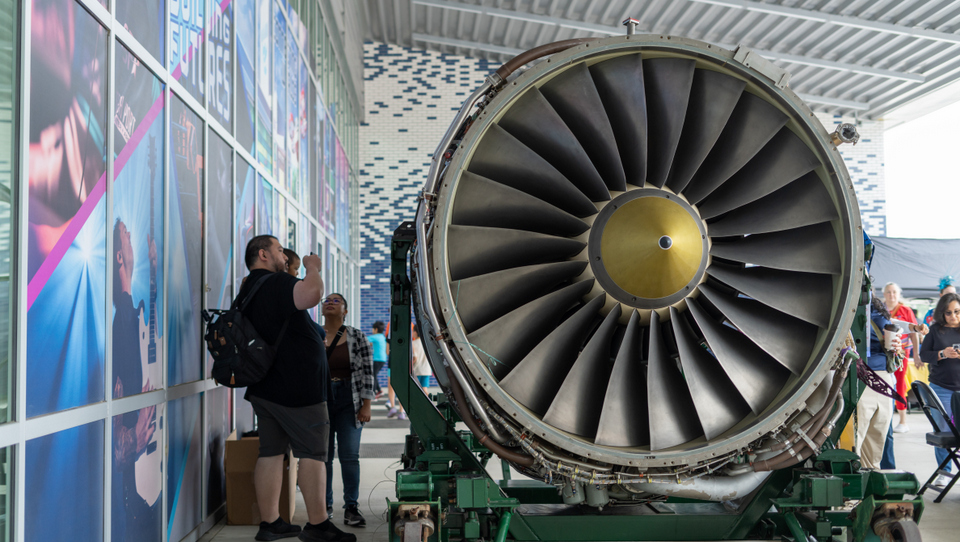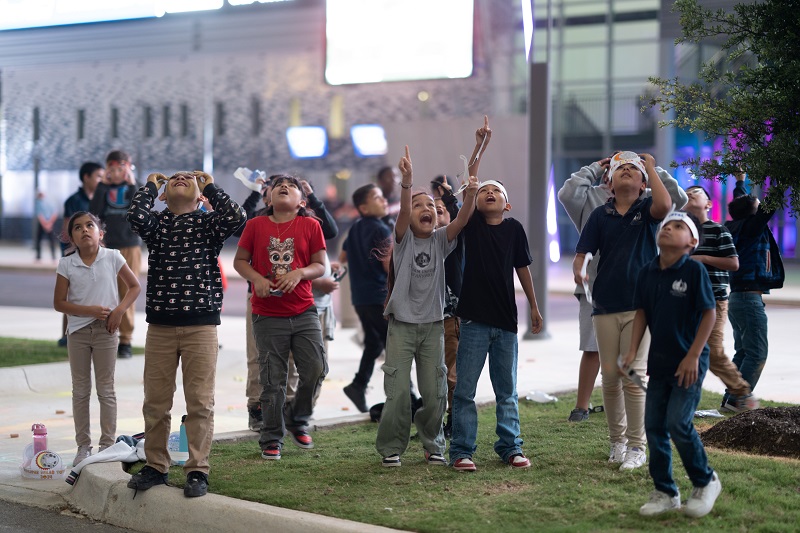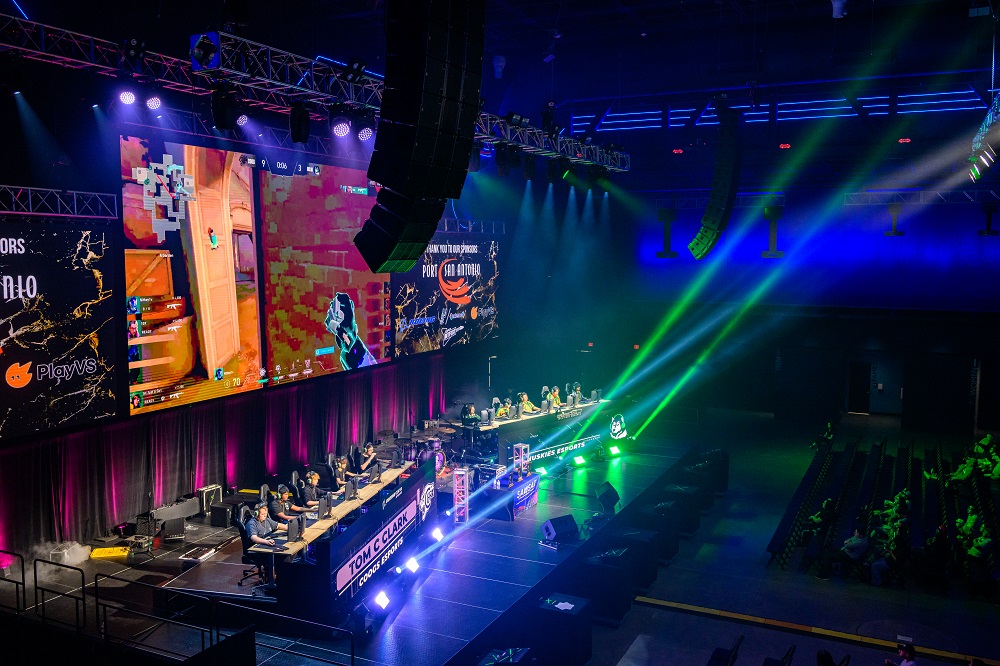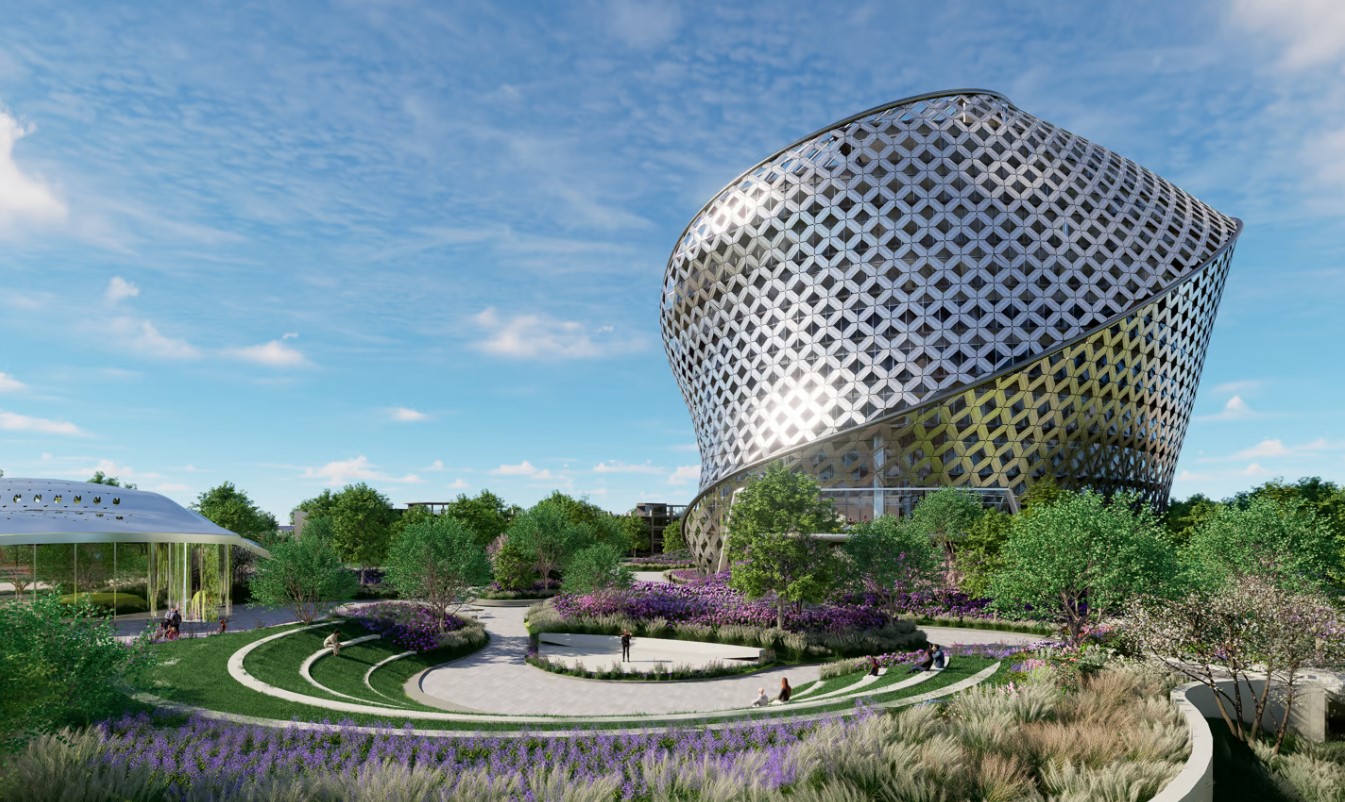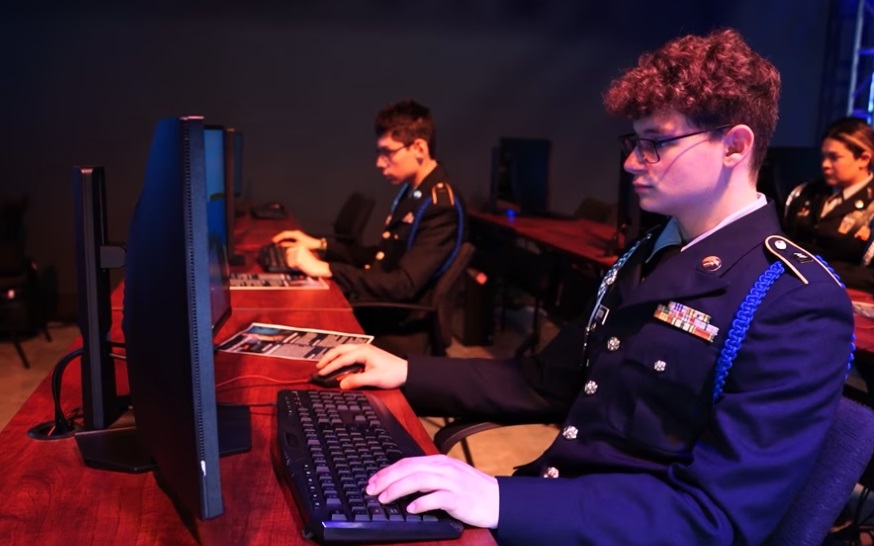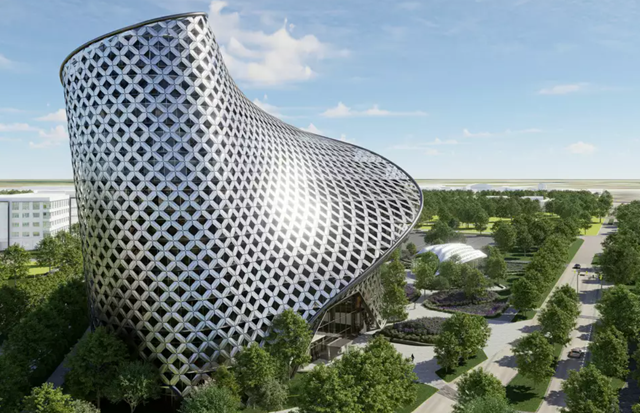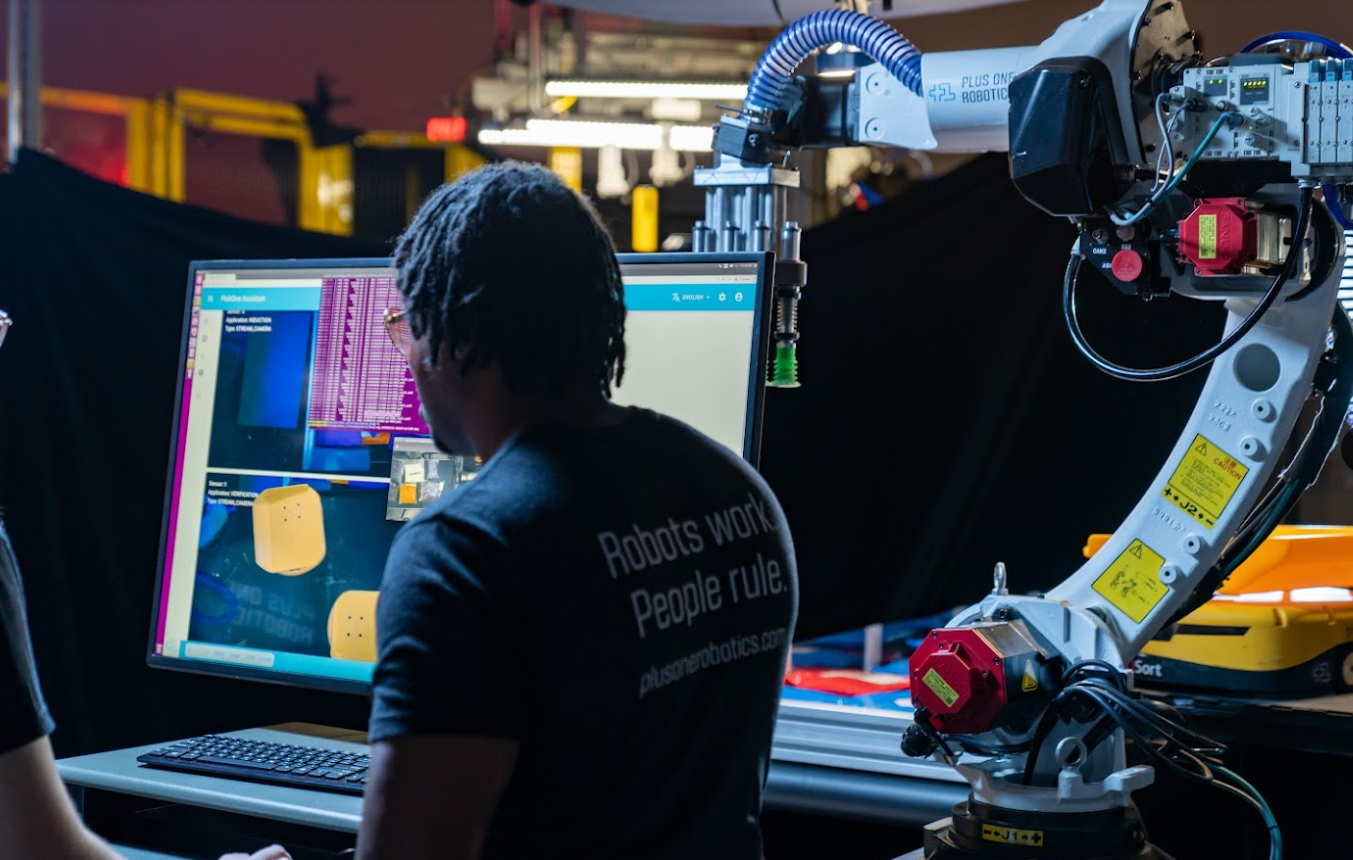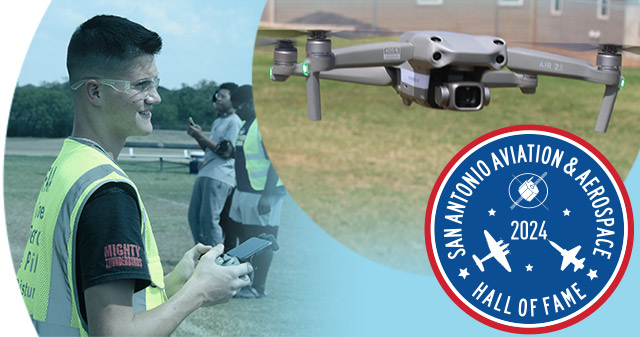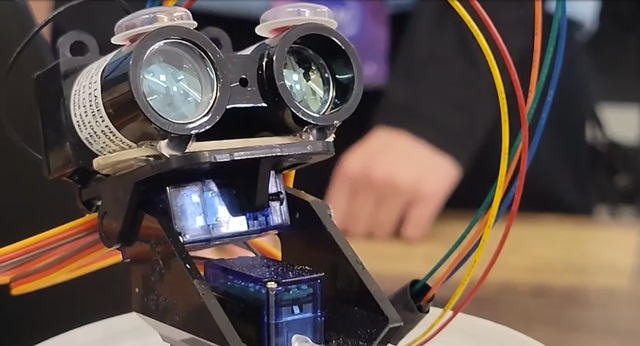GLOBAL CONFERENCE SHOWS HOW SAN ANTONIANS ARE MODERNIZING AIRCRAFT, SETTING THE COURSE FOR LUNAR SETTLEMENT AND PREPARING STUDENTS TO BECOME THE NEXT GENERATION OF INNOVATORS.
04-25-2023

Downloadable Version
ATLANTA, GEORGIA — Port San Antonio, the vast technology campus and industrial airport located just southwest of the Alamo City’s downtown, is showcasing leading efforts to connect innovations in digital security, robotics, and other applied sciences based in the San Antonio region.
Recently, the Port led a delegation of businesses and educational partner organizations as part of Aviation Week’s MRO Americas 2023 convention in Atlanta, Georgia. The event is the world’s premier gathering for technologies that support the maintenance, repair and overhaul (MRO) of the global fleets of aircraft.
San Antonio is one of America’s fastest-growing cities and has diverse and mature industry sectors. In addition to playing a leading role in the development of modern aviation throughout the past century, the region is home to significant industry clusters that are driving global innovation in aviation and an array of other sectors. Among them are cybersecurity, computing, space technology and next generation aeromedical transportation systems.
Port San Antonio’s exhibit at MRO Americas included the following:
LASER- AND ROBOTIC-BASED AIRCRAFT MAINTENANCE

The world’s largest industrial robot — developed by XYREC in tandem with San Antonio-based Southwest Research Institute (SwRI) — offers leading edge robotic technology for the painting and de-painting of large assets such as aircraft and sea vessels. Netherlands-based XYREC has headquartered its North American operations in a customized research facility next to the Port's industrial airport at Kelly Field since 2020.
The innovation is comprised of a mobile robot that measures over 72 feet (22 meters) when fully extended. It is equipped with a high-powered laser that rapidly strips paint from aircraft of any size with micron-level precision, including specified layers, without impacting the integrity of the airframe.
The large system stands on multi-directional wheels that allow it to move within a hangar and relocate to other facilities within an aircraft maintenance complex.
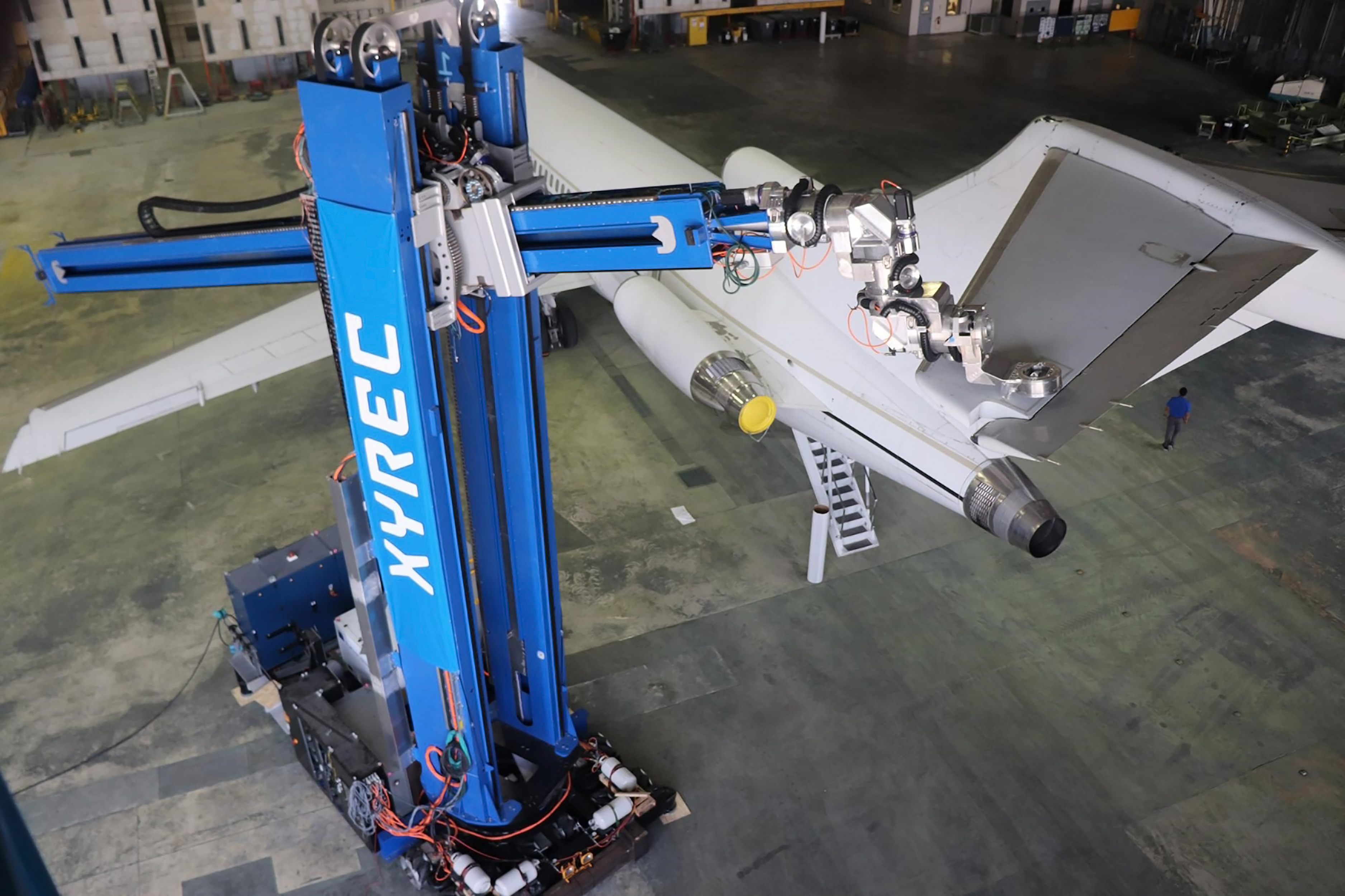
Testing of the new de-painting technology is conducted on a B727-200 aircraft.
The technology revolutionizes one of the most in-demand services required over the lifespan of a typical airplane. The world’s fleet of over 125,000 aircraft must be repainted on a regular basis to ensure aerodynamic efficiency and corrosion prevention, among other operational considerations. They are also repainted whenever an airline or other operator alters brand design elements or sells the aircraft to another user.
Traditional de-painting involves soaking the airframe with large amounts of solvents, followed by further hands-on scrubbing by technicians. This costly and labor-intensive process carries a significant environmental impact, and the chemicals could pose a health hazard to personnel.
Thanks to the new de-painting process, XYREC’s technology immediately vacuums paint particles as the laser passes over the surface of the aircraft. As the paint is removed, the particles are directly contained in a sack that can be disposed of easily.
Paint stripped from a single wide-body aircraft using XYREC's laser technology generates approximately two pounds (one kilogram) of waste in powder form. This is in stark contrast to traditional methods, in which the same aircraft will require approximately 475 gallons (1,800 liters) of harsh chemicals and an additional 3,700 gallons (14 cubic meters) of water to de-paint.
Furthermore, the overall process also eliminates up to 30 tons of carbon dioxide emissions per painted aircraft that would otherwise be generated through chemical-based methods. As the technology is adopted across the world — with a potential market of tens of thousands of aircraft as well as many more naval vessels — the cumulative environmental benefit to the planet will be significant.
For aircraft operators, XYREC’s technology significantly reduces costs and turnaround time and eliminates the need for storage, handling and disposal of harsh chemicals. That efficiency allows operators and maintenance shops to reduce overhead costs and return passenger, cargo and military aircraft back into service sooner — reducing turnaround time by up to 60 percent.
LUNAR EXPLORATION AND SETTLEMENT

A team of scientists led by space architect Sam Ximenes and backed by NASA is preparing humankind's next big leap forward: a return to the Moon and, subsequently, human travel to Mars.
Ximenes is the founder of the educational nonprofit WEX Foundation and commercial enterprises XArc Exploration Architecture Corp. and Astroport Space Technologies, Inc. — all of which are based on the Port's campus. Together, the three organizations are raising San Antonio's global profile as a leading place with expertise in an array of space disciplines, particularly building habitats, factories and other infrastructure that will be essential for the successful colonization and commercialization of extra-terrestrial realms.
Astroport and Southwest Research Institute (SwRI) recently developed an initial set of recommendations that were published in the prestigious Planetary Science Journal of the American Astronomical Society (AAS) in an article titled Leto Mission Concept for Green Reconnaissance of the Marius Hills Lunar Pit. They recommend launching unmanned spacecraft and robots to explore a cave in the Marius Hills region of the Moon, which they believe can eventually be developed for future human settlement. The Marius Hills Hole is a 45-meter (147-foot) deep hole in the lunar surface that serves as a giant skylight or opening to a potentially extensive cave system that could be part of a large underground lava tube.
The authors believe the Marius site can eventually be developed for future human settlement, and Astroport has subsequently released a series of videos illustrating how potential development evolves from initial reconnaissance by robots to a complete lunar settlement by the end of this century. (You can view these videos, which cover an introduction to LEAP2, the detailed Leto mission and the infrastructure build-out phase, by clicking on the respective links.)
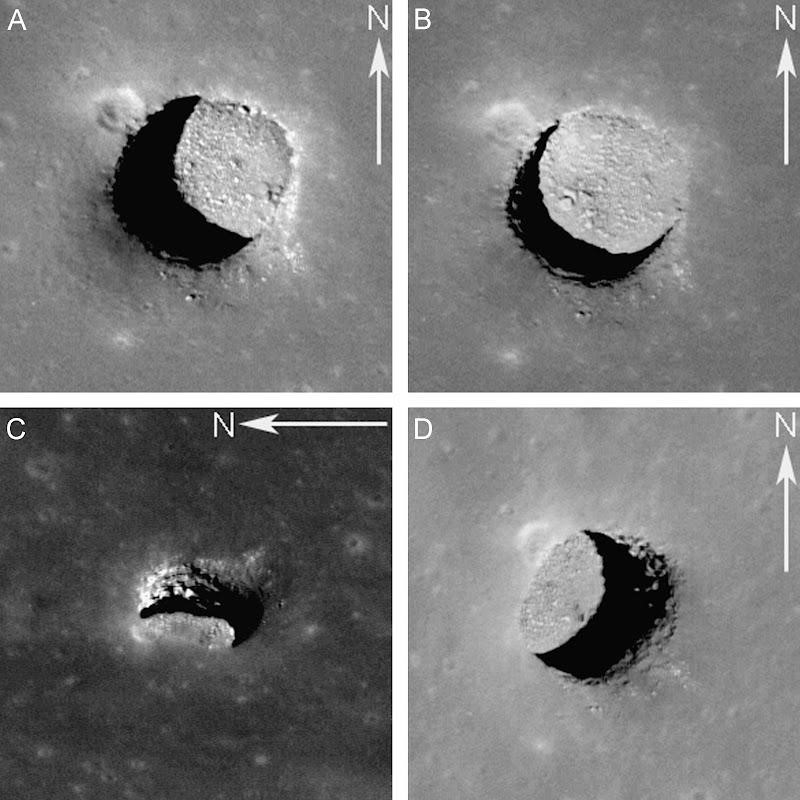
Proposed location of the LEAP2 lunar settlement. (image credit: NASA/ASU Marius Hills region and Marius Hills Hole)
Settlement of the Moon will be a critical step in addressing pressing concerns on Earth. Among the innovations that will be supported by settlements are factories that will use minerals that are in abundant supply on the lunar surface as a source material for the construction of massive satellite arrays — some of them several miles in length — orbiting the Earth.
These would include satellites that harness vast amounts of solar power, convert it to electricity and transmit it wirelessly as microwaves back to receiving stations on Earth — a concept that scientists at NASA and across the world have considered for decades.
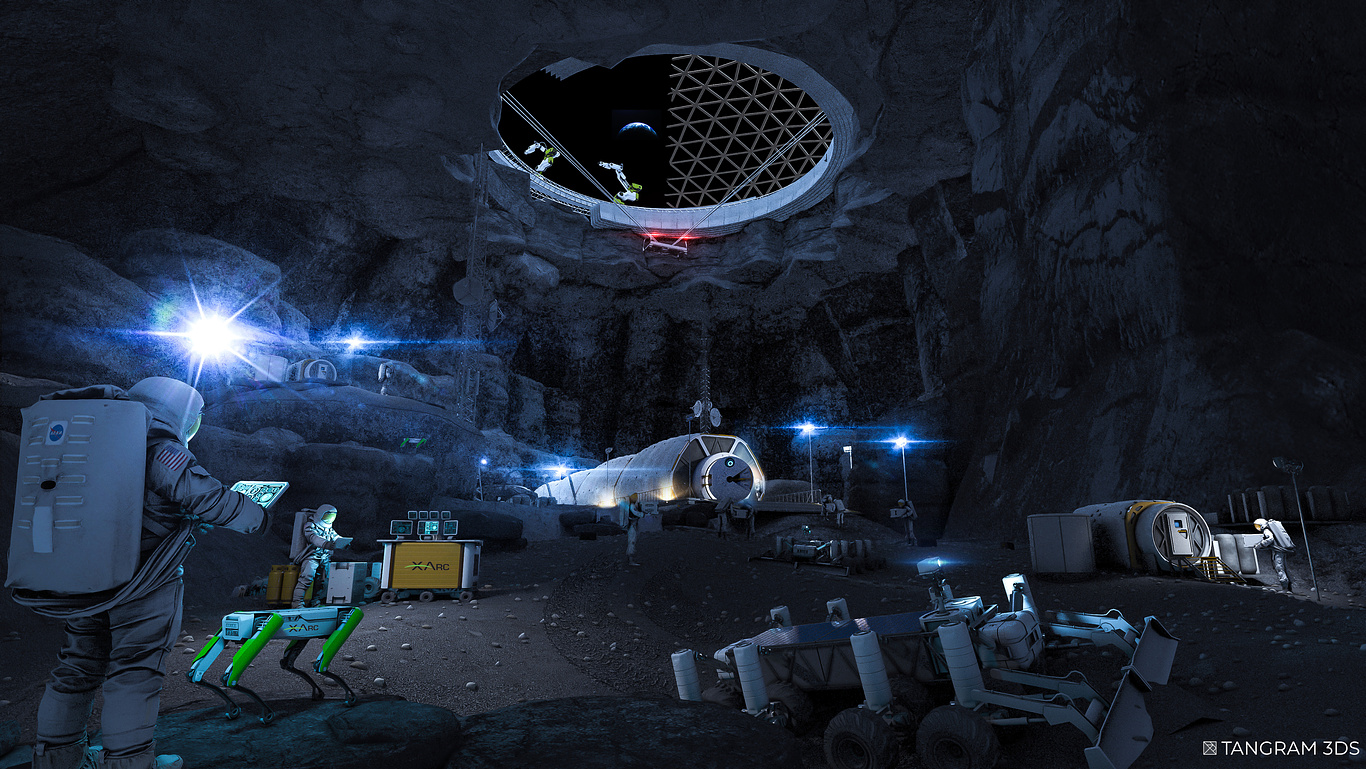
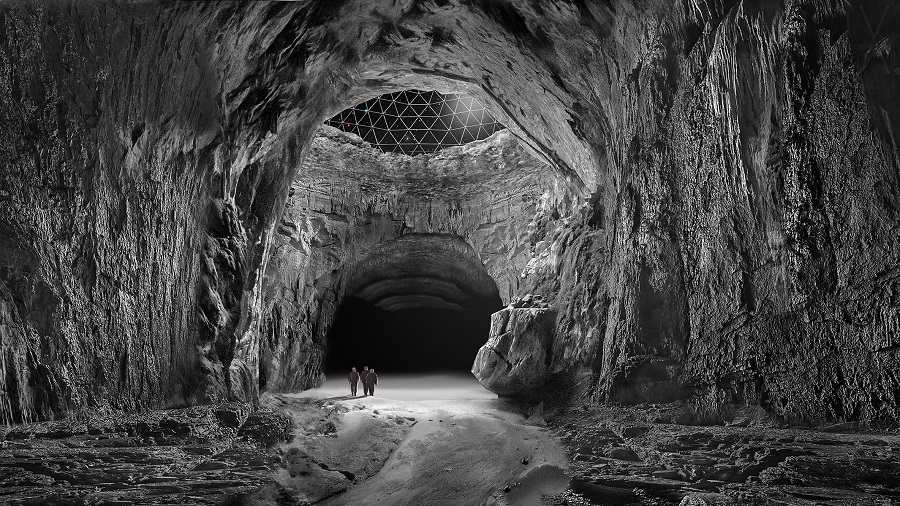
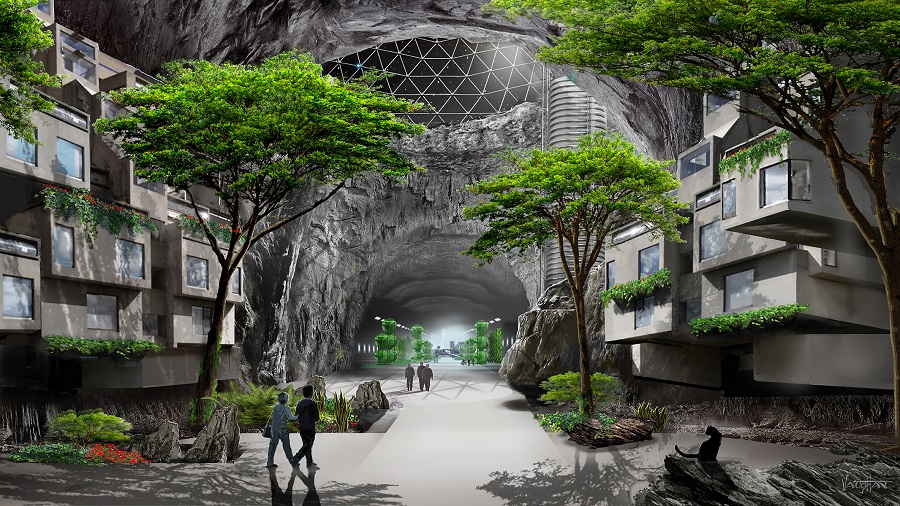
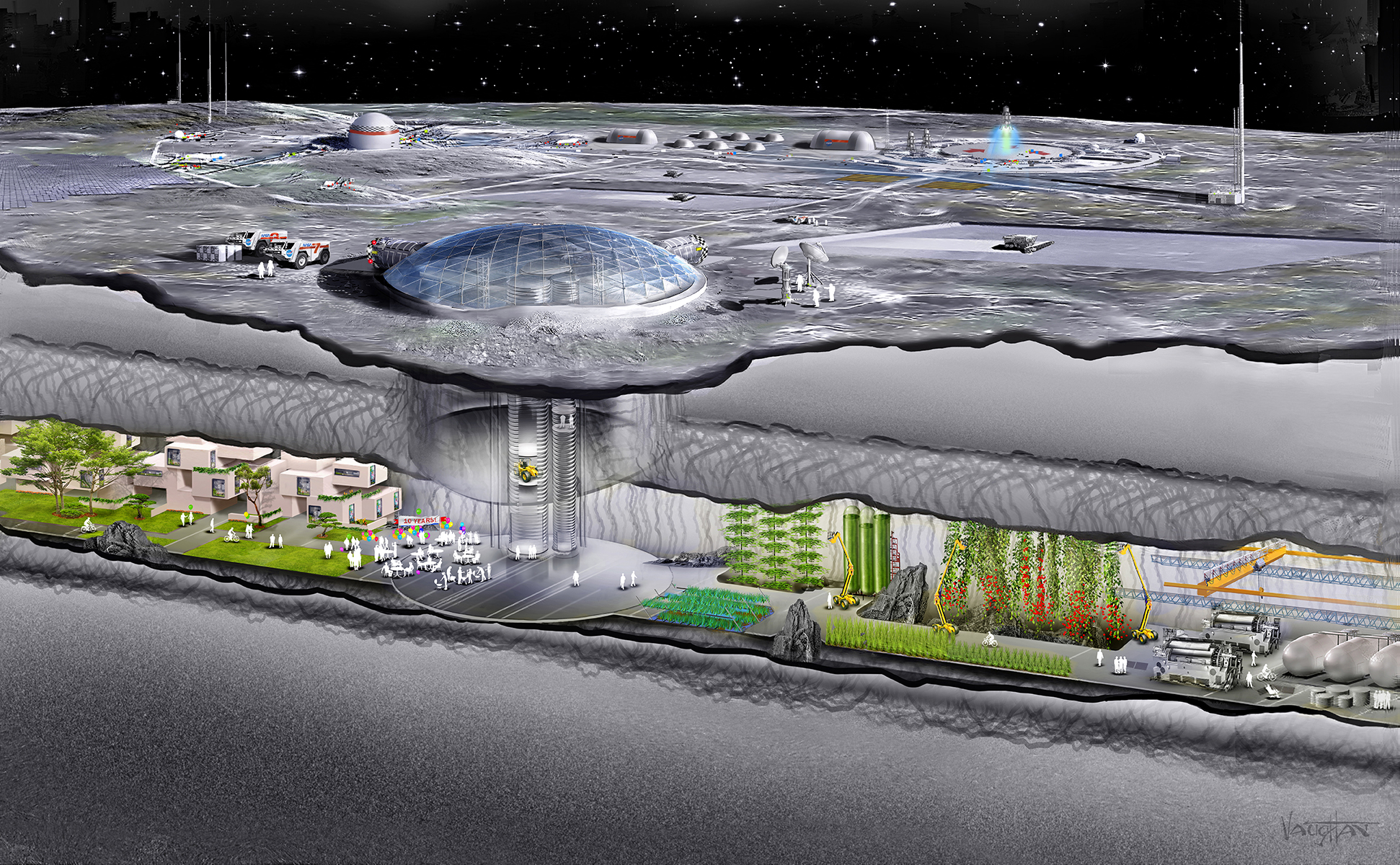
ABOVE — Conceptual renderings of a lunar lava tube as it is developed as a human settlement. (Image credits: XArc)
With one-sixth of Earth's gravitational pull, sourcing materials from the Moon and launching them toward a terrestrial orbit will prove far more efficient than sending supply rockets directly from Earth.
Additionally, the partners are advancing research on how infrastructure on the Moon can be built using dirt rocks, also known as regolith, that comprise the lunar surface as the principal building material. By heating the minerals into a molten state similar to volcanic lava on Earth, a system of robots and large 3D printers can use the material to create the initial landing pads, habitats, factories and other infrastructure long before the arrival of humans.
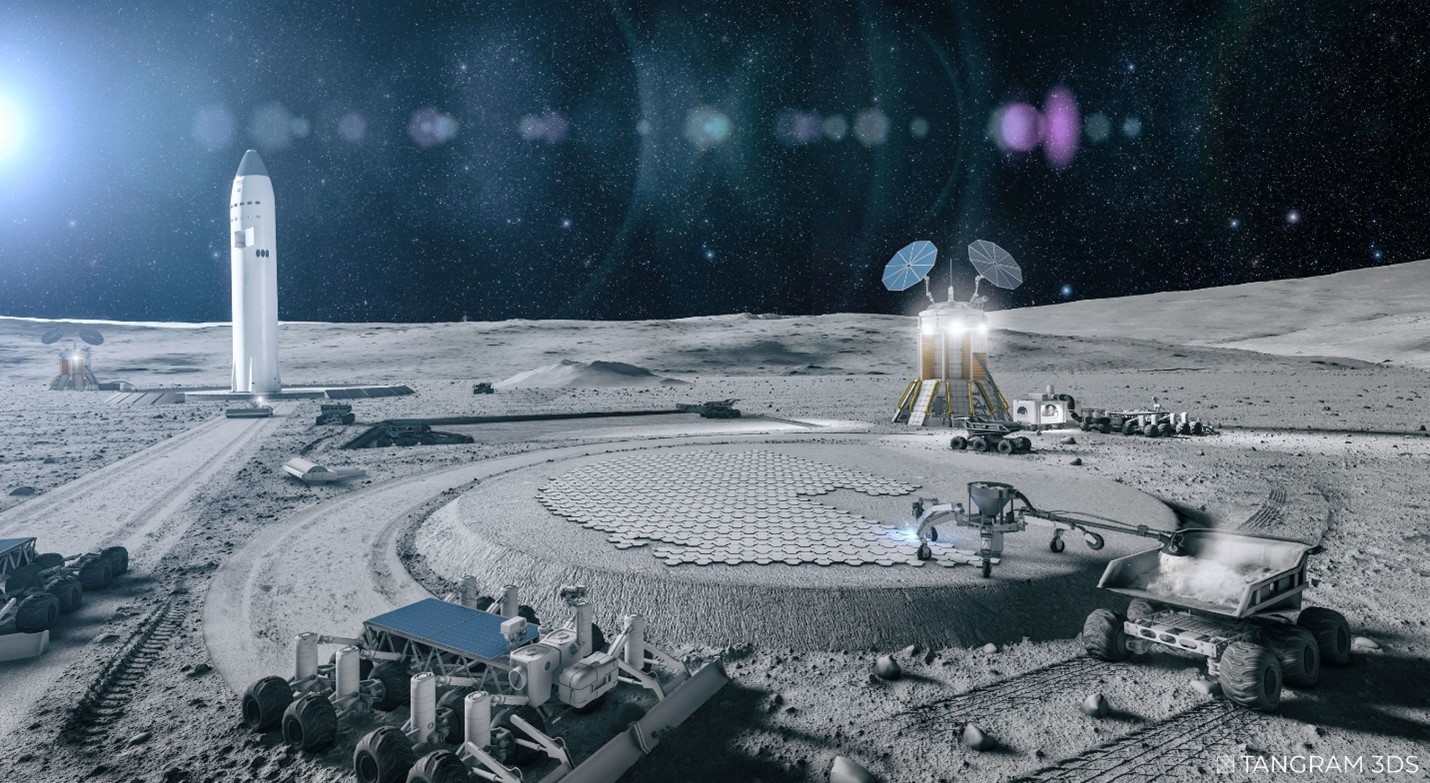
Rendering of what the early phases of a colony on the Moon might look like. In the foreground, robots are building a launch pad with bricks created by grinding, melting and re-shaping basaltic moon rocks. (Image credit: XArc)
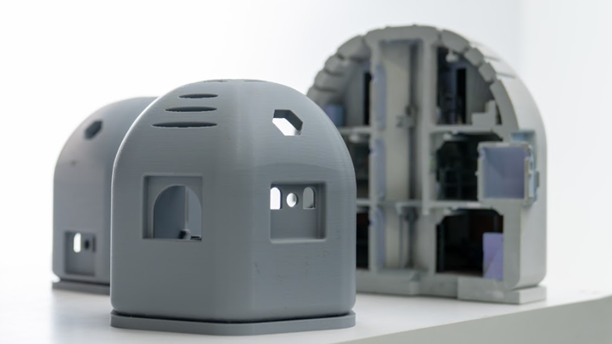
Scale models of future habitats on the Moon designed and created with three-dimensional building technology by young students participating in WEX Foundation programs.

Building blocks for extra-terrestrial colonization: Powdered basaltic matter is subjected to high temperatures in the research team's experimental vacuum oven and then molded into bricks to create building components for landing pads on the Moon and Mars. Image credit: Astroport Space Technologies/WEX Foundation.

AN INNOVATION DESTINATION
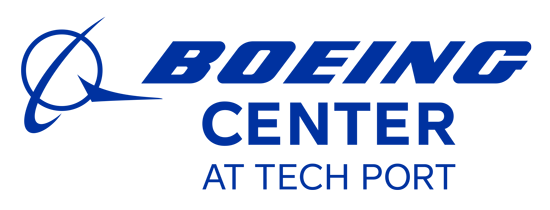
At MRO Americas, the Boeing Center at Tech Port, a state-of-the-art innovation center in the heart of the Port campus, also took center stage. The facility was completed in 2022 and spans more than 130,000 square feet as a strategic site like no other in the nation that leverages human capital, industry expertise and a broad range of capabilities in education.
This collaborative space is accelerating the development of new technologies and serves as a showroom to sell innovations similar to those showcased at MRO Americas and connect them to global markets, particularly in the aviation, energy, defense, cybersecurity, robotics, manufacturing and biomedical sectors.
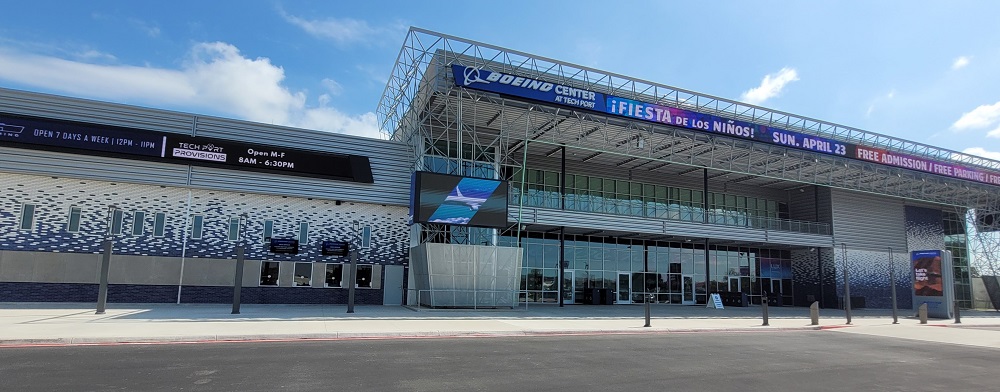
Boeing Center at Tech Port (above). The large building provides multiple spaces to host different types of activities, including the following: conventions, product launches and other large gatherings; spaces for different stakeholders to prototype and showcase new technologies; meeting rooms and classrooms; and spaces, including a state-of-the art LAN gaming center and adjacent food hall, for technology enthusiasts to gather and socialize.
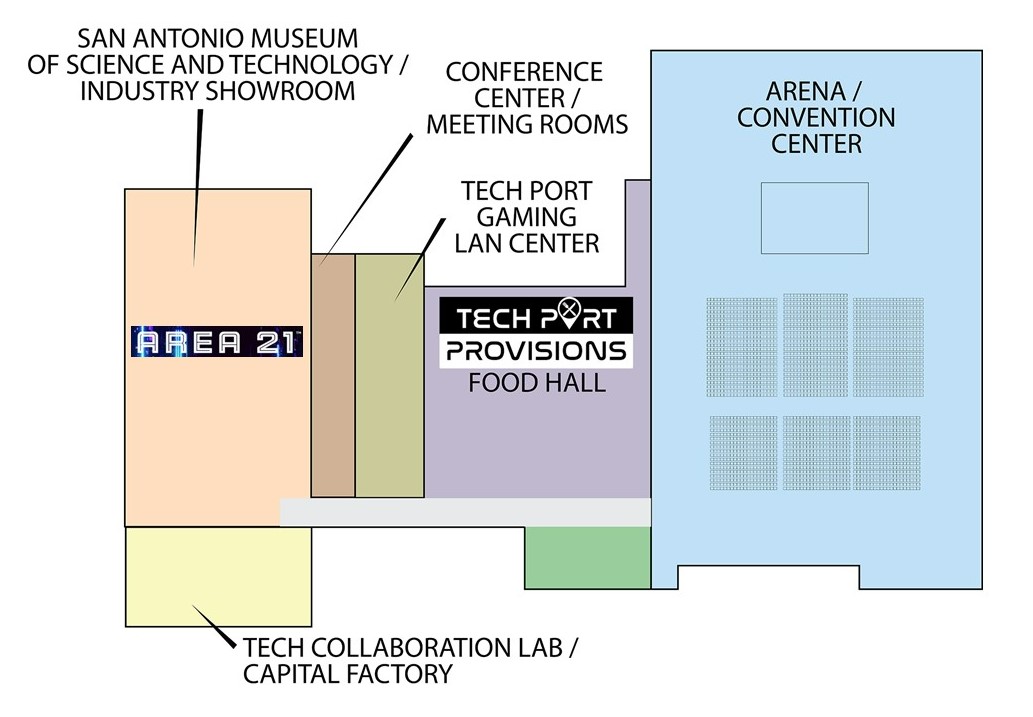
Components of Boeing Center at Tech Port include a 3,500-seat arena/conference venue, a publicly accessible industry showroom and collaborative spaces where different industries can work together in the development of new applied technologies in aerospace and other disciplines.
Boeing Center at Tech Port provides industries and partners on the Port campus and beyond with a place to conduct training and public demonstrations to strengthen collaborations, increase the understanding of emerging technologies, particularly the application of new breakthroughs to enhance capabilities in mature sectors, and serve as a showcase for new approaches that can be adopted by others.

Located in the heart of the Port’s 1,900-acre industrial campus, Boeing Center at Tech Port is surrounded by leading names in aerospace, education, defense and other advanced industries.
The facility is anchored by a 3,500-seat modern technology arena that can be configured for different uses, including esports competitions, concerts, product launches and large training programs. Retractable seating allows the space to host conventions and conferences as well.

The Boeing Center at Tech Port arena is the largest space in the nation purpose-built for esports. In 2022, the venue hosted a major Overwatch competition with thousands of on-site spectators and many more who watched the game online thanks to the space's extensive live broadcasting capabilities.
The arena has hosted an array of industry events since opening in May 2022, including Battle for Texas — a tournament for the Overwatch League that determined the top-ranked esports team in Texas. Subsequent industry and esports events held at the arena include the following:
- FORCECON22: The first-of-its-kind event promoted synergies between the Department of Defense, private tech firms and academia in advancing innovation and research.
- Innovation Rodeo: Entrepreneurial servicemembers from across the nation took part in a Shark Tank-style competition to pitch their innovations and win a share of a prize pool totaling over $1 million.
- Battle for Texas: The first esports tournament held at Boeing Center at Tech Port, Battle for Texas saw the Dallas Fuel and Houston Outlaws vie to be the #1 team in the state.
- Cyber Future Summit: Over a thousand leading experts from around the world came together to share their technologies and best practices for defending critical assets from cyberattacks.
- 13th Annual San Antonio Mayor's Cyber Cup: This event welcomed students who were among the region's participants in CyberPatriot XV, a yearlong nationwide defensive cybersecurity competition.
- 2023 San Antonio Aviation and Aerospace Hall of Fame: Hosted by the Dee Howard Foundation, the event welcomed over 500 local leaders, teachers and students to honor local aerospace innovators while preparing the next generation of talent to take flight.
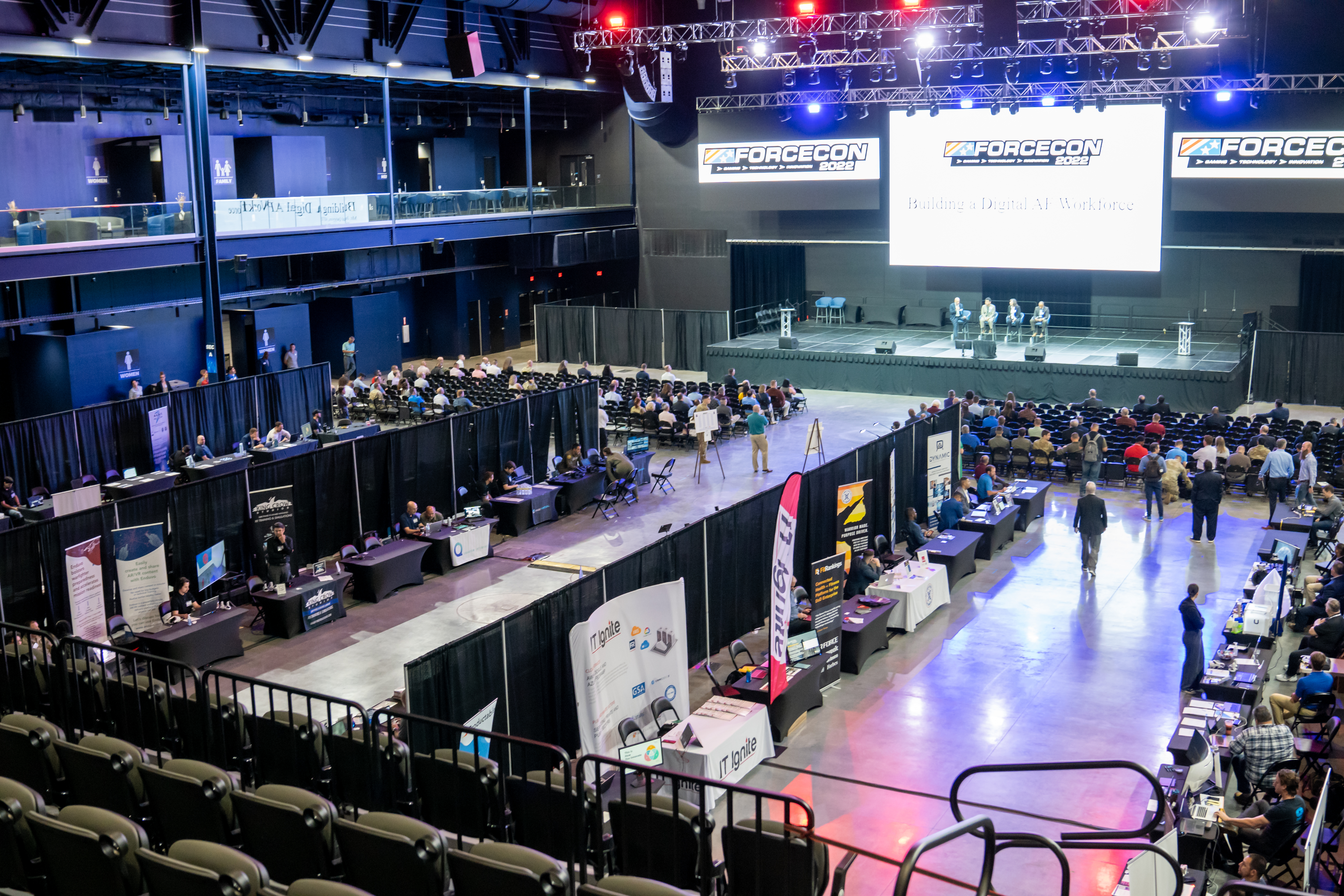
FORCECON22 was a two-day, invitation-only industry showcase and networking opportunity initiated by the U.S. Air Force and included a collider event (above) and a friendly esports match featuring the Air Force Gaming team (below). Photo credits: ASM Global/Port San Antonio.
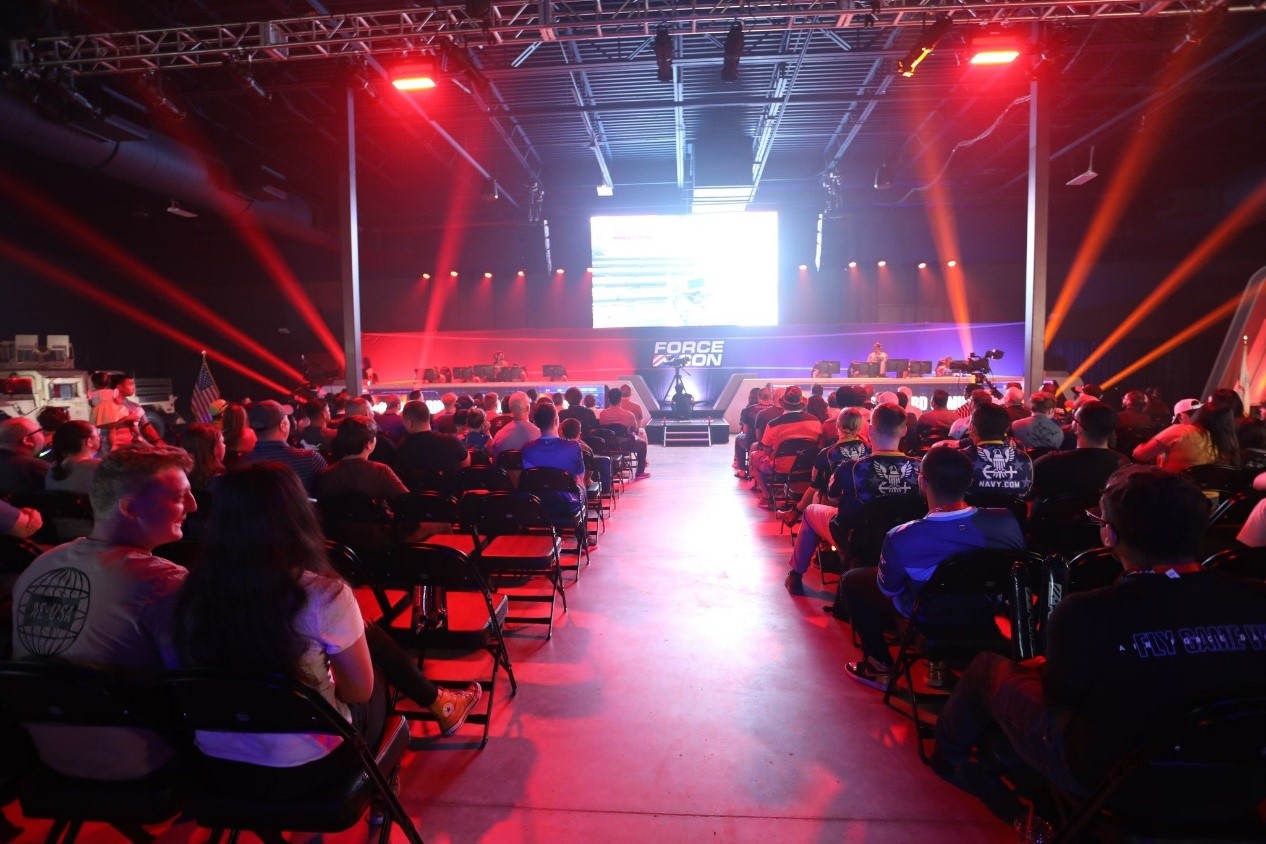

A key component of the facility is the participation of Capital Factory. The Austin-based accelerator has established its Center for Defense Innovation (CDI) within the collaborative lab space at Boeing Center at Tech Port.
Programming led by Capital Factory allows an array of startups to better collaborate with one-another, research partners, mature enterprises, the Department of Defense and other entities. Similarly, activations by Capital Factory rely on the lab space, as well as the adjacent museum, classroom spaces, LAN gaming center and arena, to showcase innovations developed by its stakeholders to an array of audiences, including potential buyers regionally, nationally and globally.
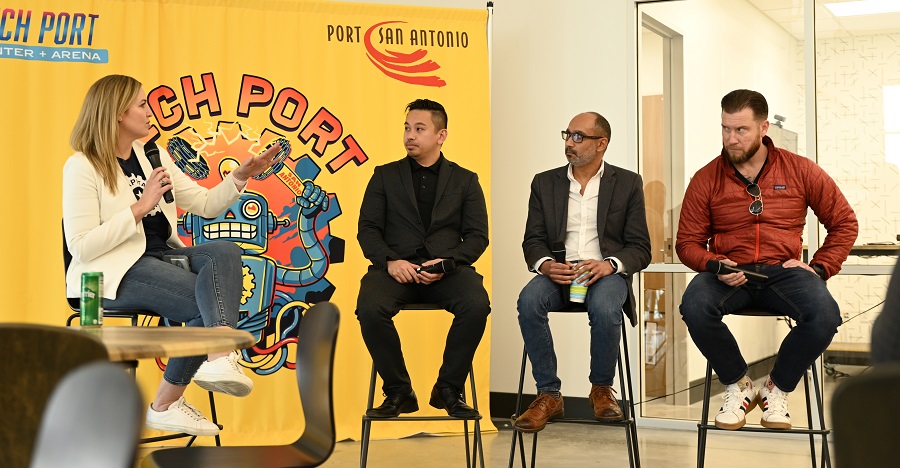
Local entrepreneurs exchange ideas during a panel discussion at a Defense Academy workshop hosted by Capital Factory. The accelerator’s presence at Boeing Center at Tech Port allows local startups to collaborate and share their technologies with an array of potential buyers, including the Department of Defense and mature industries.

The Yellowjacket Drone, developed by Darkhive. The San Antonio-based startup, supported by Capital Factory, is leading efforts to integrate drone technology as part of national defense and public safety operations.
It is also an important platform to accelerate and significantly grow regional educational initiatives focused on aerospace and an array of other technologies—from innovative STEM programs for young people launched by Port-based San Antonio Museum of Science and Technology (SAMSAT) to advanced training for seasoned professionals within the U.S. Air Force and other entities.

Boeing Center at Tech Port has quickly emerged as the nation's top esports gaming venue, thanks in part to a top-tier LAN gaming center that has attracted some of the most proficient players from around the world. Boeing Center at Tech Port is the largest facility in the nation purpose-built from the ground up to host an array of esports activities.
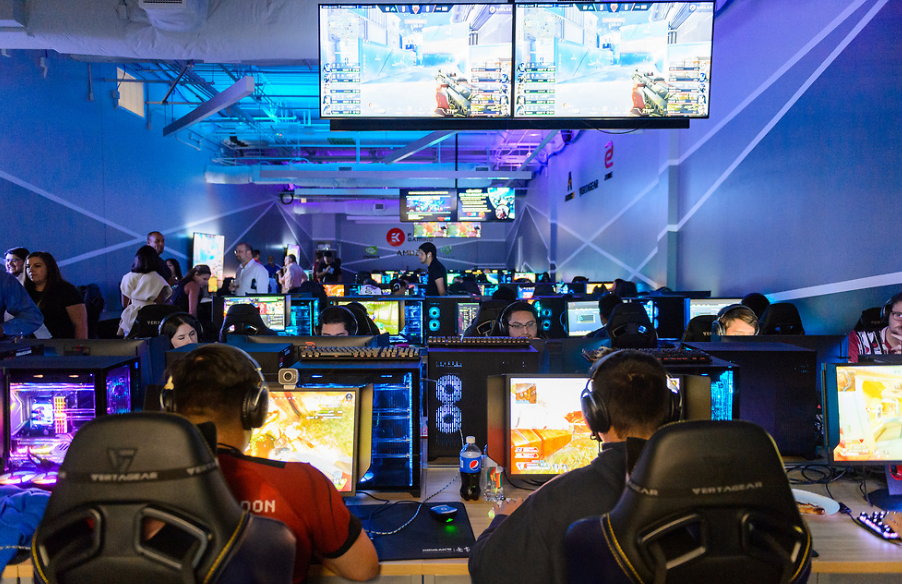
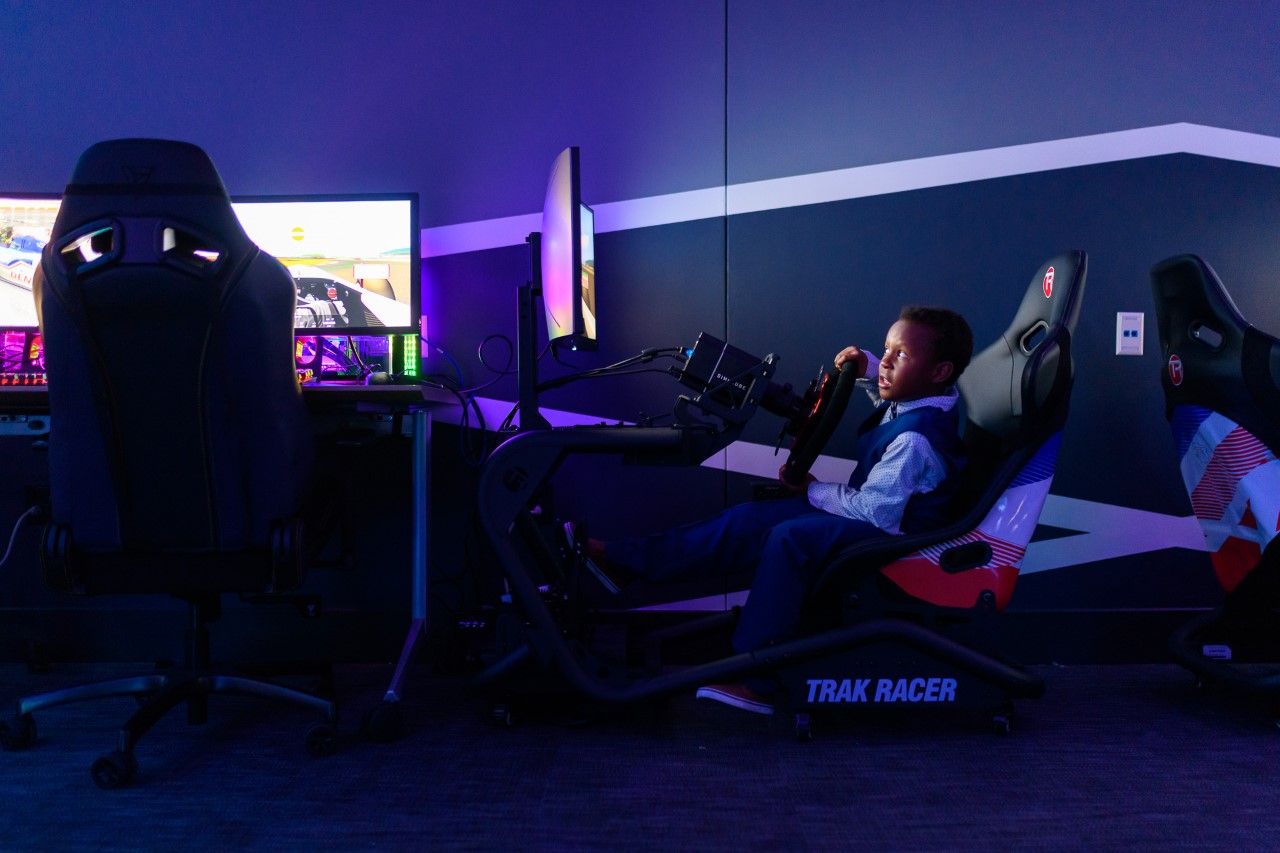
Photo credits: Mark Sobhani

In 2022, SAMSAT launched AREA 21, which is an expansive space that features large-scale 3-D printing demonstrations, a cybersecurity operations center that simulates real-life scenarios and threats, self-driving vehicles, robotics exhibits and flight simulators, among other innovations developed locally.
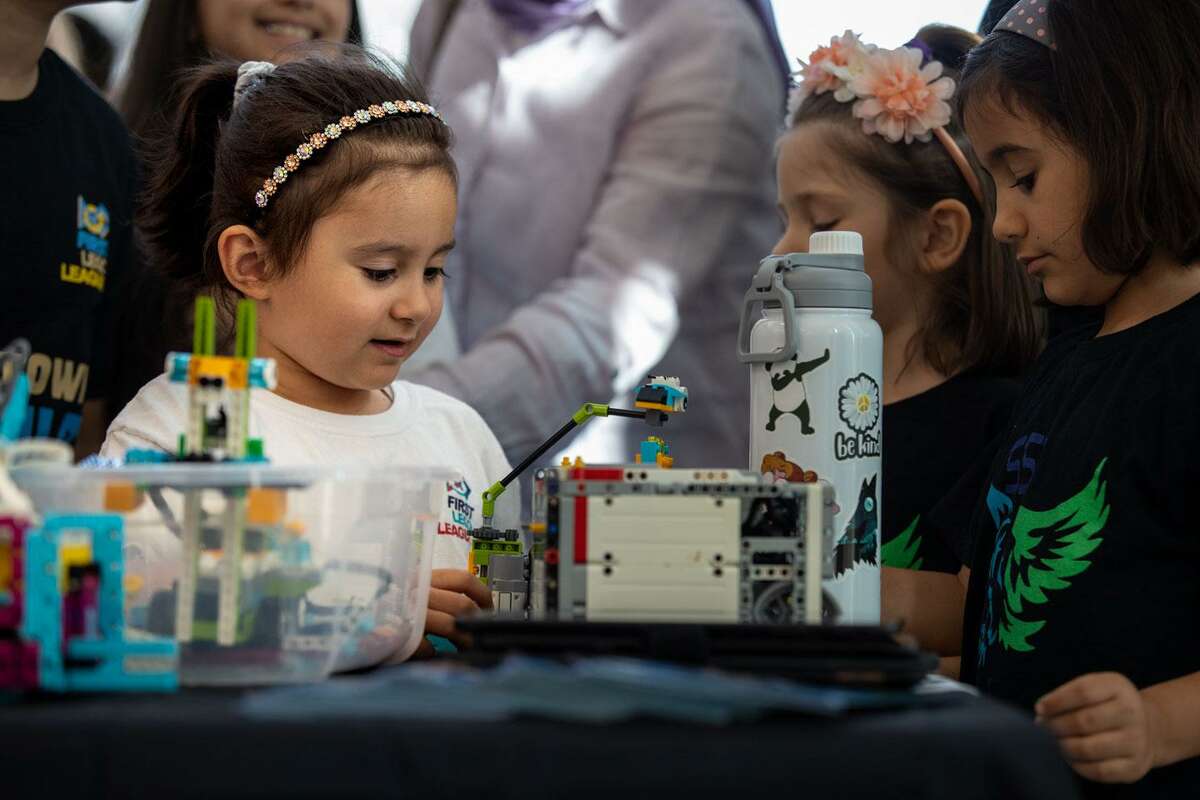
Photo credit: San Antonio Express-News.
Since SAMSAT first moved to its initial facility at the Port in 2017, more than 130,000 students from across the community have engaged with hands-on learning delivered by top experts in fields that include cybersecurity, aerospace, lunar architecture, robotics, bioscience and others. The expanded space at AREA 21 has the capacity to accommodate well over 150,000 K-12 visiting students every year through activities that include enrichment programs coordinated with all area school districts, summer camps and internship and volunteer opportunities.
AREA 21 has also enhanced the range of exhibits that give visitors a close-up, hands-on experience of industries on the Port campus and across the region. The WEX Foundation and Astroport, cybersecurity leader CACI, Plus One Robotics, Northworks Automation, Andy Robot and Southwest Research Institute are among the organizations who have contributed to the continually evolving set of exhibits and programs that showcase ongoing developments in San Antonio's tech community.
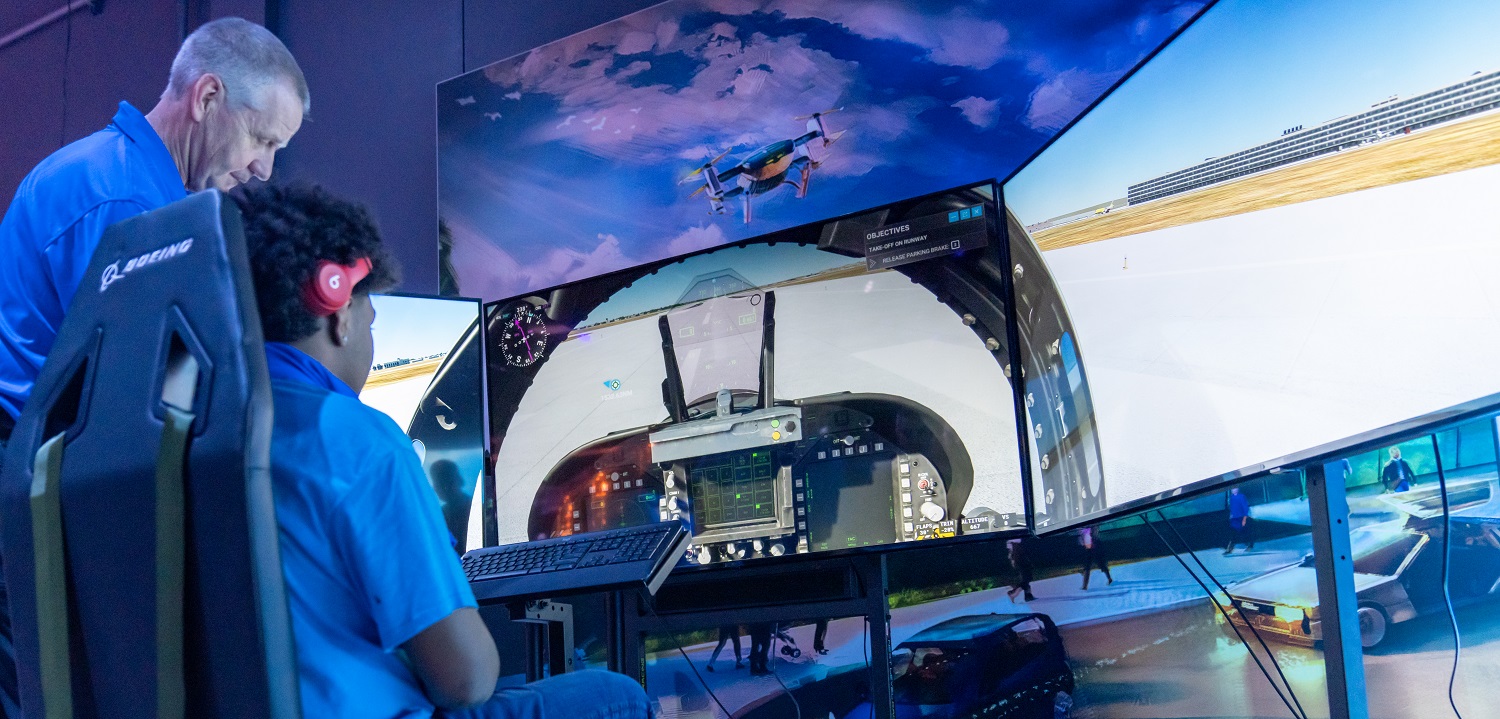
Flight simulator at AREA 21, located within Boeing Center at Tech Port. At MRO Americas 2023, Port San Antonio is featuring a similar electric vertical take-off and landing flight simulator, courtesy of SAMSAT.
Furthermore, AREA 21 is strengthening Boeing Center at Tech Port's growing profile as a destination for regional, national and global innovators, and it is becoming a home to a vibrant mix of activities that connect industries, educators, the public and potential buyers across the nation and around the world while bolstering San Antonio's tech ecosystem.
Port San Antonio's exhibit at MRO Americas 2023 featured an electric vertical take-off and landing flight simulator and an esports station, both courtesy of SAMSAT. The flight simulator foreshadows the Port's development plans to support future air mobility and urban transport by constructing its own vertiport, while the esports station enables attendees to experience the popularity of video games first-hand as they continue to be implemented into educational curricula and professional training programs with greater frequency.

Area students take part in educational programs at AREA 21’s security operations center simulator. Photo credit: Port San Antonio.
AN ENDURING PARTNER
A new partnership between Boeing and the Port will expand STEM learning and workforce development across South Texas.
Boeing's $2.3 million investment in the Port-affiliated educational nonprofit Kelly Heritage Foundation, announced in January, is strengthening the region’s STEM talent and enhancing programming that includes curricula developed by SAMSAT on the Port campus. And through a separate agreement with venue operator ASM Global, Boeing is also the sponsor of the Port's 130,000-square-foot exhibition center, now dubbed the Boeing Center at Tech Port.
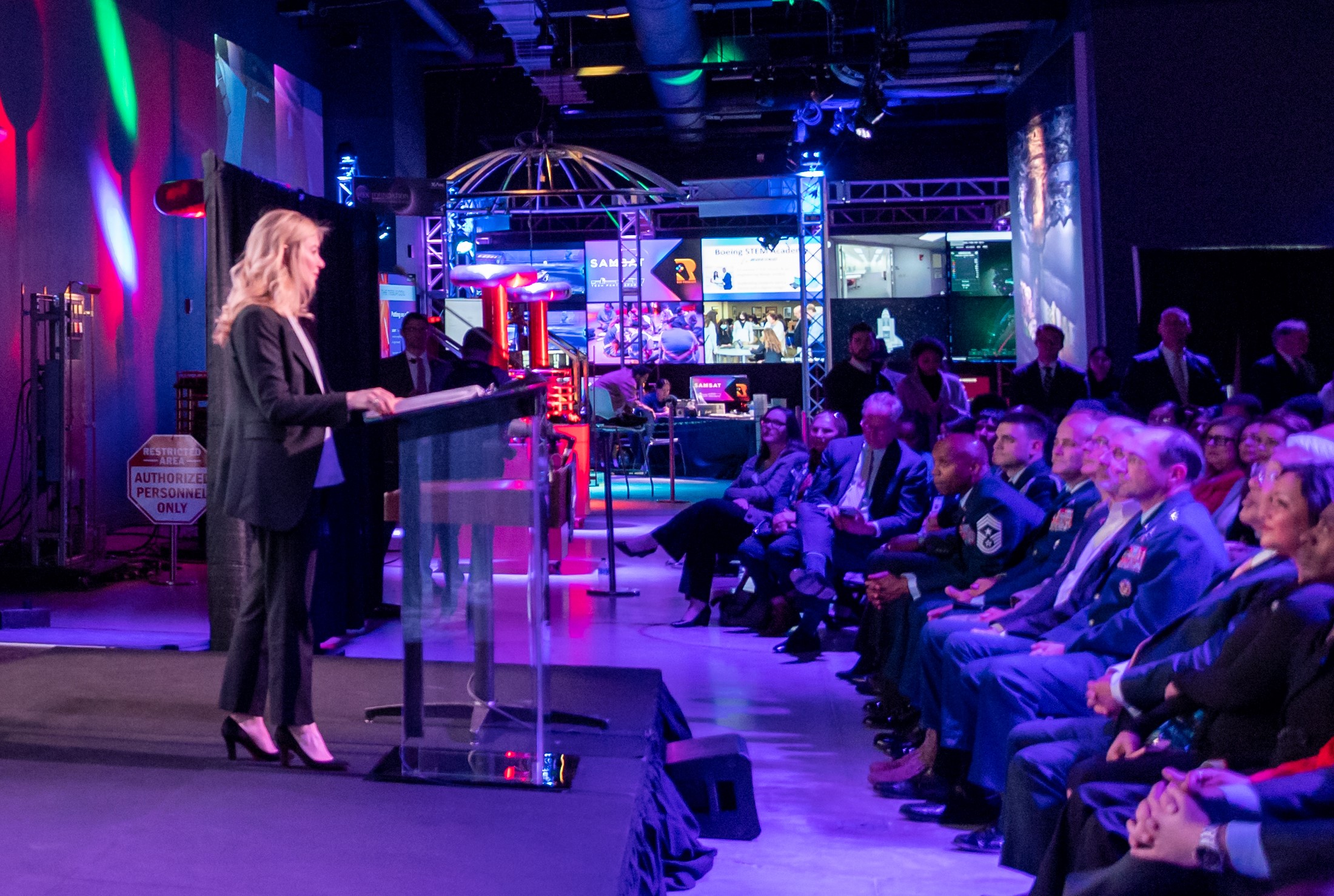
Boeing Global Services CEO Stephanie Pope (above) and Texas Governor Greg Abbott (below) address attendees during a January 2023 event to announce Port San Antonio's partnership with Boeing in advancing STEM education for the San Antonio region.

For more than 20 years, Boeing’s aircraft maintenance and modernization operation has been growing at the Port, furthering its support of an array of military and commercial aircraft. The new STEM programming will focus on developing skills that are key to the aerospace and space exploration industries, including robotics, artificial intelligence, 3-D printing, virtual reality, cybersecurity, visual sensors and more.
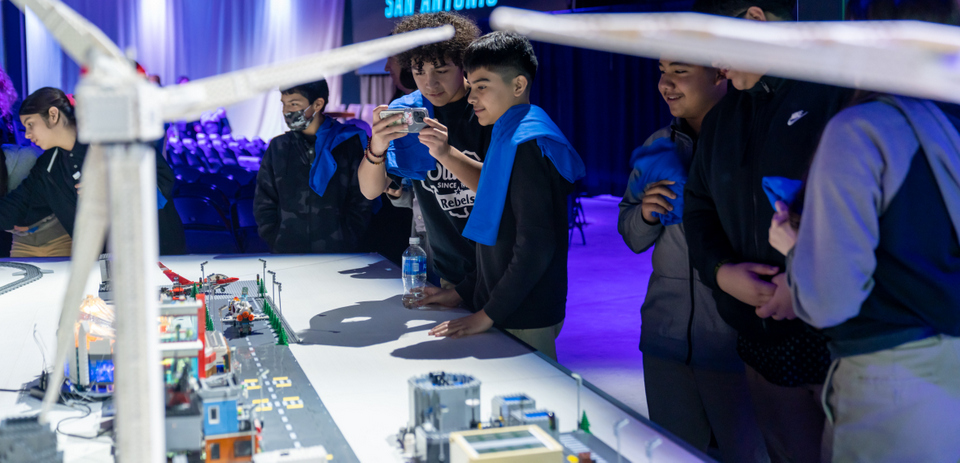
BUILDING FUTURES
A vertiport to host passenger and cargo electric vertical take-off and landing vehicles (eVTOLs), a modern multi-story office building and a research complex that will include a simulated lunar terrain lab are among the Port's ambitious development plans that will further grow the region's profile as a global innovation destination.
The new facilities will support an array of operations hosting thousands of additional workers who are advancing nationally-important projects in fields already thriving on the Port's vast campus: aerospace, space-based manufacturing, cybersecurity, energy, robotics and other applied technologies.
The planned facilities represent hundreds of millions of dollars in additional investments by the Port, which is focused on ensuring the participation of enterprises of all sizes from across the region.
The first of these projects — the modern multi-story office building — was approved by the Port's Board of Directors in April 2023 and is now in the pre-development phase with global real estate development partner Trammell Crow Company (TCC). Along with design architect firm Pelli Clarke & Partners, the Port is working toward refining demand and design concepts for the ambitious project.
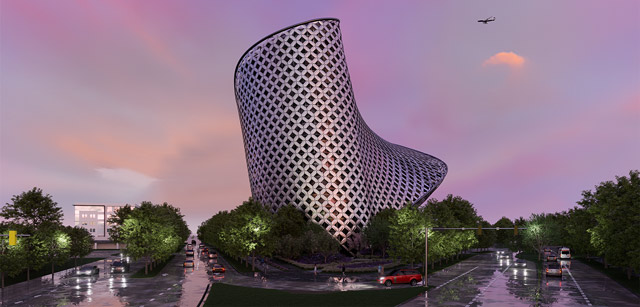
Conceptual rendering of an upcoming multi-story office building near the Port's main entrance at General Hudnell Drive. Credit: Port San Antonio/Pelli Clarke and Partners.
The planned tower will be a marquee centerpiece for the region's growing profile in advanced technologies and will create opportunities for an array of local businesses. Its development and construction come at a time when the Port has attracted substantial demand for space as its customer base grows at an accelerated pace. Since 2017, over 7,000 new jobs have been added on the campus, bringing the current employment base to 17,000.
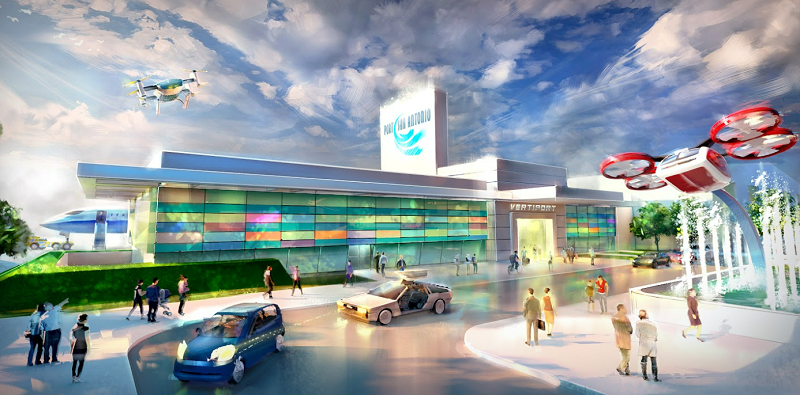
Conceptual rendering of the upcoming vertiport / fixed-base operator at Port San Antonio, able to accommodate traditional winged aircraft and a new generation of passenger electric vertical take-off and landing vehicles (eVTOLs).
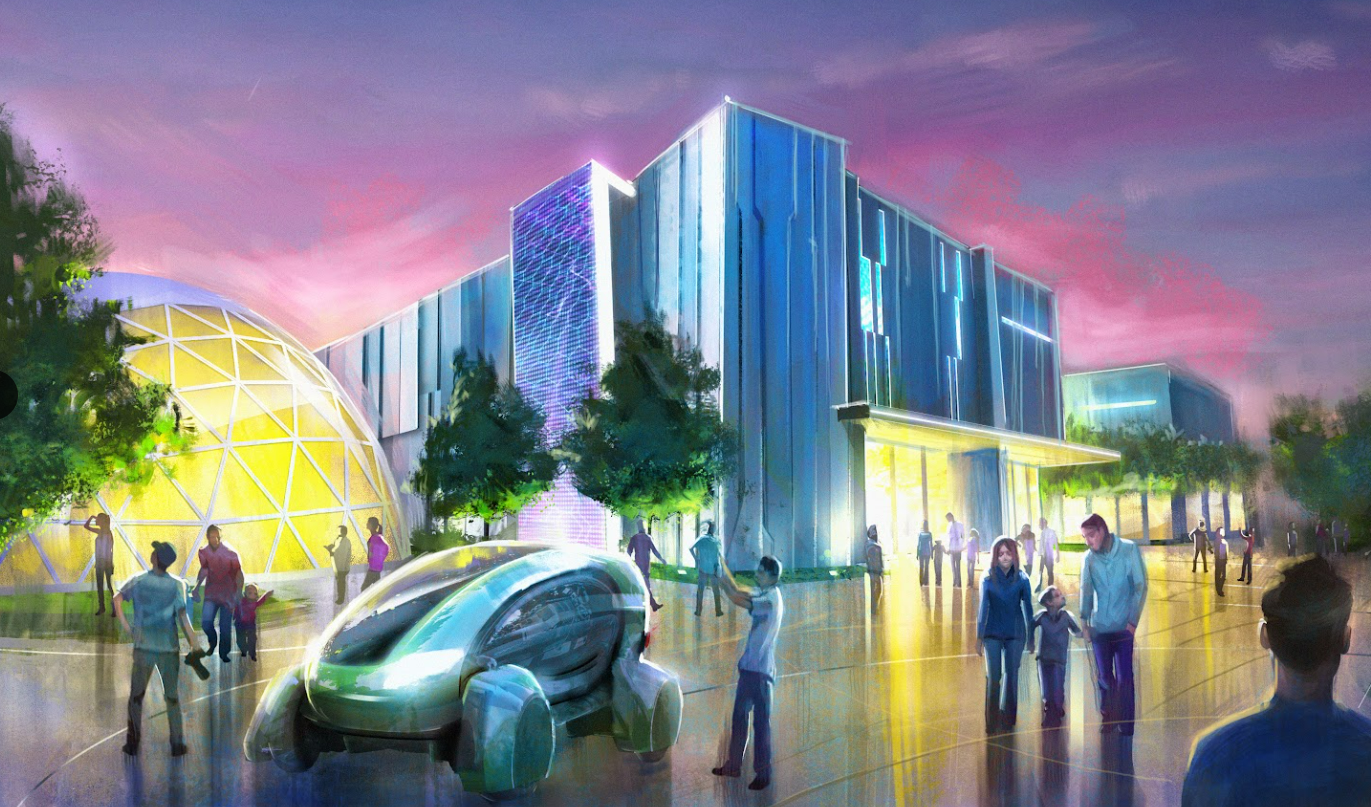
Conceptual rendering of the upcoming research complex at Port San Antonio; the domed structure to the left illustrates a laboratory with a simulated lunar terrain to advance research in space-based manufacturing and related technologies.

